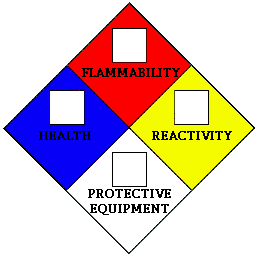 .
.
Also refer to:
We have done everything we can to make this laboratory as safe as possible;
we cannot, however, completely protect you without your cooperation. There
are very hot furnaces, powerful acids, and strong solvents which are all
used, so you must be careful. If you do not show sufficient regard for safety,
you will be told to leave the lab, and your grade will suffer accordingly.
This section of the lab manual is intended to give some general guidelines,
but the most important item is your COMMON SENSE.
--Wear glasses whenever you are in the laboratory.
If you do not ordinarily wear glasses, get a pair of safety glasses from
the apparel cabinet when you put on your lab coat.
--Never wear shorts or open shoes to this lab. You must always wear
long pants and regular shoes when you work in this lab to help insure your
safety.
--Keep all the chemicals, whether in beakers or bottles, under the hoods
at all times.
Before beginning any work, make sure the water is running in the sink and
leave it running at all times. Whenever working under the hoods you should
wear the green acid/solvent
resistant gloves over your normal gloves. When you finish, rinse the
gloves in running water, then remove them, and finally rinse your
normal gloves. If you think any liquid has penetrated the gloves, remove
them and thoroughly wash your hands. The large sink in the lithography room
is more convenient for rinsing your arms than the fume hood sink.
--Never mix an organic solvent with an acid: the combination may
explode.
Always rinse chips with high purity water between etching steps and solvent
cleaning steps. Acids should be diluted with water in a large beaker, and
then poured down the drain very slowly, with the sink water running. Solvents
such as ethanol may be poured down the drain with water dilution. TCA
should NOT be poured into the city drains.
HYDROFLUORIC ACID
We use a 10% hydrofluoric (HF) acid mixture for etching SiO2. HF is
EXTREMELY DANGEROUS, and we use it ONLY IN THE HF ETCHING HOOD.
AT NO TIME IS ANY OTHER PROCESSING TO BE DONE IN THIS HOOD. One major
problem with HF is the fact that it does not hurt immediately after exposure.
When it does begin to hurt a few hours after exposure, it is too late. It
will slowly eat through tissue over the course of several days, until it
reaches bone, where it is neutralized by calcium. It is excruciatingly painful.
Although an HF burn is very serious, it is also very easy to prevent. Only
when the acid is left in contact with the skin for an extended period is
it dangerous. Our procedure is very simple: always wear the green gloves
when working at the HF etch station, and rinse them with water frequently.
When you finish, rinse thoroughly, and finally rinse your hands and arms.
The etch station itself is designed to minimize the chance of exposure,
but always be VERY CAREFUL. I have never seen a serious HF accident, but
this is only because all the labs I have worked in treat it with healthy
paranoia. Please do not break my record.
If an accident does occur, there is both a safety shower and eyewash next
to the main door. For any chemical splash onto a person's face, they should
immediately go to the eyewash and activate it. You should put your face
into the water stream and rinse for at least several minutes. For whole
body splashes, pull down on the safety shower handle, and leave the water
on. A non-injured person should use the phone next to the spill kit
to call for emergency help if necessary:
DIAL 911 FOR EMERGENCY HELP.
TELL THE CAMPUS OPERATOR YOU ARE LOCATED IN ENS 214
NOTIFY ME AT ONCE IN CASE OF ANY ACCIDENT.
UT Austin EMERGENCY INSTRUCTIONS
Please see the Materials Safety Data Sheets (MSDS)
in Section VI of this Lab Manual for more information.
Other web sites with useful lab safety information:
 .
.